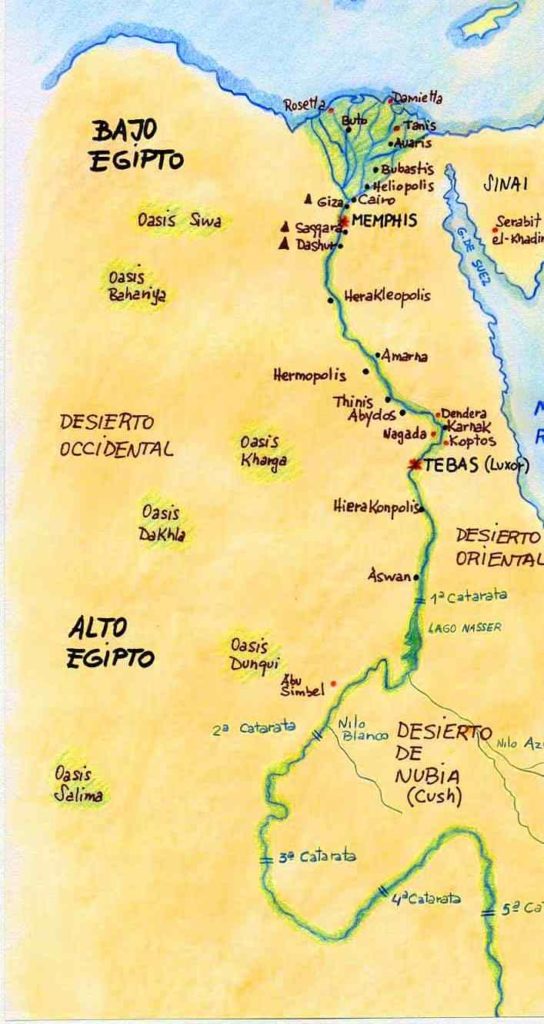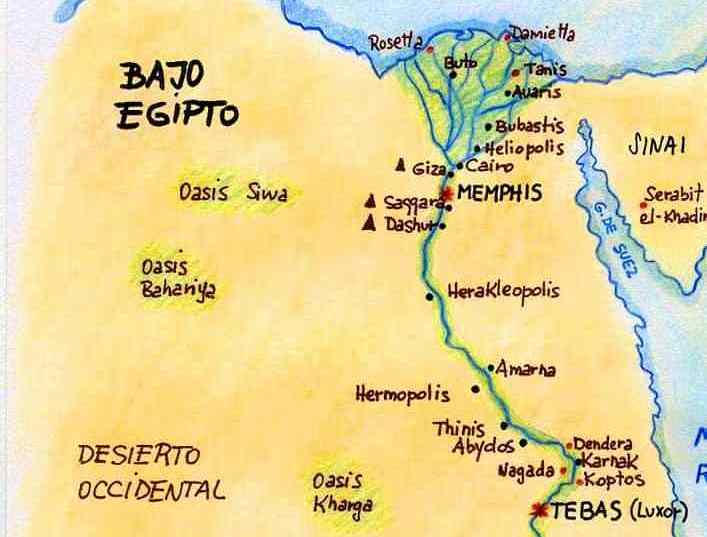Ancient cities of Egypt map
Although the most important city in the Ancient Kingdom was Memphis, the capital, numerous cities (rural towns and urban centers) were scattered throughout ancient Egypt, mainly in the Nile Delta and in the Nile Valley.
Urban centers concentrated ideological culture, trade and wealth. They were true cultural and religious centers.
Rural populations, the basis of the economy, were essentially made up of free farmers, ranchers and workers who received their wages in kind. Private property existed.
The workers were free men according to documents that refer to stonemasons, mine workers, etc. They used to work in groups of ten, led by mayor foremen; wages were paid in kind (bread, wheat, textiles, beer …).
Ancient cities of Egypt map in the Nile Delta
Tanis: The main deities worshiped in Tanis were Amun, his wife Mut, and their son Jonsu.
Memphis: It was the capital of the Ancient Kingdom of Egypt and the nome I of Lower Egypt. It was located south of the Nile River Delta, in the region between Lower and Upper Egypt.
It was founded around 3050 BC by the first pharaoh of Egypt, Narmer.
Bubastis: The oldest strata date from the Old Kingdom, having references to kings of dynasty IV, as well as temples of dynasty VI (Teti and Pepi I) and a necropolis.
(Heliopolis): Its birth dates from before the year 3000 BC and during Dynasty II it was an important astronomical center. It is probable that the Heliopolis Solar Temple was similar to the type of Abusir solar temples, built during the V dynasty that, 2400 BC established the cult of Ra as the main cult.
Remains of the wall and some temple have been found, of which the main one must have been that of Amun and that of Ra.
Towards the middle of the second millennium BC, the city reached its maximum splendor, and around 1300 BC reached its maximum extension.

Sais or SA Al Hagar: The oldest settlements date back to the Buto – Maadi Culture (c. 3500 BC). Both the names of two queens, which contain the word “Neit” (Meryt-Neit and Neit-hotep), and allusions to the city in the times of Pharaoh Hor-Aha, could indicate the great prestige acquired during the Archaic period.
From then on and for a long period, the history of the city can be followed, mainly, by the ceramic remains found, dating from the Old and New Kingdoms.
Athribis or Hut-Repyt: ancient city the Panopolite nome of Lower Egypt. The deity worshiped in Athribis was the crocodile god later assimilated to Horus.
Busiris: it was the capital of the IX nome of Lower Egypt [Per Usir] means “The Abode of Osiris”
Buto: It was an ancient city of the VI nome of Lower Egypt; it was the capital of the kingdom of Lower Egypt during the Protodynamic period, being finally subdued by the southern kingdom.
Mendes: It was an ancient Egyptian city in the Nile delta area. Its Egyptian name was Per-Banebdjedet which translated means “The domain of the ram, lord of Djedet” and was the center of the cult of the Banebdjedet, mentioned by Herodotus.
Previously the city was called Djedet and the main cult was the fish goddess Hatmehit.
Some mastabas from the Old Kingdom have been found, some monuments from the time of Ramses II, Merneptah and Ramses III, and a temple erected by Amasis (on another previous temple) that was consecrated to the gods Ra, Osiris, Shu and Geb.
This temple was formed by four monolithic blocks of which only one is preserved, almost eight meters long, which corresponds to the god Shu, located to the southwest; the temple was restored by Ptolemy II Philadelphus.
Ancient cities in Middle Egypt
Heracleopolis Magna: main city of the 20th nome of ancient Upper Egypt, in the El Fayum region.
It was the seat of the rulers of dynasty IX, and dynasty X, during the first intermediate period of Egypt. After reunification, the city lost importance.
Qis or Cusae (Al Qusiyyah): it was the capital of nome XIV of Upper Egypt. Various inscriptions attest that the city of Qis name existed from the Old Kingdom, as the capital of the nome and center of worship to Hathor, which was worshiped in the form of a white cow.
Two necropolises are known: Mair, west of the current city, and al-Amarna Qusair on the eastern bank of the Nile.
The latter was used only in the Old Kingdom and by few people, while the Mair necropolis was used in the Kingdoms: Old Kingdom (sixth dynasty), Middle (twelfth dynasty).
Ancient cities of Egypt map







